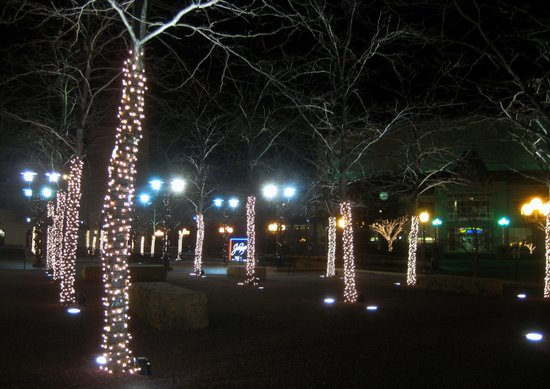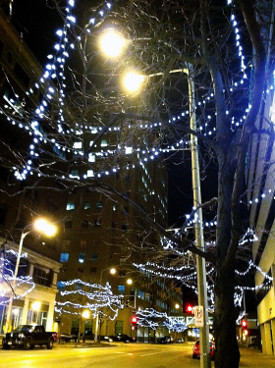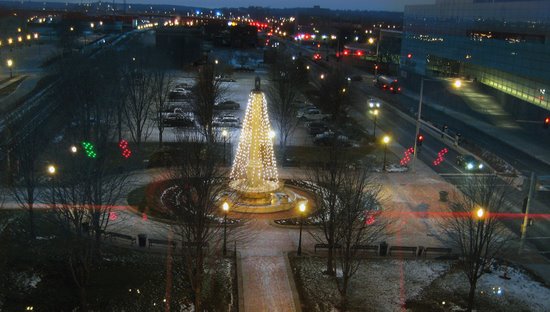
It's easy to start taking outdoor Christmas lights for granted about now. They have been draped over trees and strung along porch railings and under the eaves for weeks - even longer in the shopping centers.
Though often used with little real thought, they have symbolic connotations. It is intriguing to think of them as a modern equivalent of the Yule log that warmed our distant ancestors during the winter solstice. Or the guiding star over Bethlehem on the first Christmas.
Pause for a moment and consider how remarkable it is that these tiny electric lights can transform a bleak winter night into a delicately laced wonderland. How leafless trees can become magical, and simple homes can become places of wonderment. How they brighten more than the longest nights of the year. How fond memories grow from these fragile strings of lights.
Outdoor lights are typically like party decorations used to lend a festive air, although a unique Christmas display might be regarded as a kind of folk art. And the John Deere Commons in Moline is transformed into a spectacular landscape simply by the electric lights wrapped around the trees between the Deere Pavilion and the i Wireless Center. It is not out the question to think of such a display as environmental art.
 In downtown Davenport, more than 32,000 bulbs were used to light the trees that line Second Street, the Dillon Memorial in LeClaire Park, and the Genesis Remembrance Tree in Bechtel Park near the Arsenal bridge. The uncluttered and unfussy placement of lights, the consistent and purposeful color, and the use of LED bulbs give a contemporary feel to the displays. On the other hand, the vintage-styled street lights and the surrounding brick buildings evoke a sense of the past. We are definitely on a slippery slope aesthetically when a description begins with an impressive number, but the downtown area is a successful combination of new and old that doesn't feel forced.
In downtown Davenport, more than 32,000 bulbs were used to light the trees that line Second Street, the Dillon Memorial in LeClaire Park, and the Genesis Remembrance Tree in Bechtel Park near the Arsenal bridge. The uncluttered and unfussy placement of lights, the consistent and purposeful color, and the use of LED bulbs give a contemporary feel to the displays. On the other hand, the vintage-styled street lights and the surrounding brick buildings evoke a sense of the past. We are definitely on a slippery slope aesthetically when a description begins with an impressive number, but the downtown area is a successful combination of new and old that doesn't feel forced.
Outdoor electric holiday lighting became widespread in the late 1930s, more than half a century after Edward Johnson - an inventor who worked for Thomas Edison - first lighted an indoor Christmas tree with 80 small light bulbs in 1882. Johnson went on to create the first mass-produced string of electric Christmas lights around 1890.
However, electric lights did not become immediately popular. The cost of the lights and the services of an electrician to install them was out of the reach of all but the wealthy. One estimate puts the cost of lighting an average Christmas tree with electric lights at the beginning of the 20th Century at $2,000 in today's dollars.
Christmas lights for outdoor use first became accessible to the general public in the late 1920s. There were sets offered for sale before then, but they were too dangerous, expensive, and impractical for the average family.

It is through the family home - not businesses or city administrations - that holiday displays really come to collectively convey a full range of emotions, from the subtle, quiet mood evoked by a single candle placed in every window in a darkened house to the exuberance of larger-than-life inflated Santas on motorcycles in the front yard. Driving through neighborhoods with lights and decorations on house after house, one can sense joy, playfulness, a keeping-up-with-the-neighbors competition, humbleness, and spirituality. That - the expression of feelings and ideas through the creative use of tools and media - is the nature and meaning of art.
Bruce Walters is a professor of art at Western Illinois University.
This is part of an occasional series on the history of public art in the Quad Cities. If there's a piece of public art that you'd like to learn more about, e-mail the location and a brief description to BD-Walters@wiu.edu.








